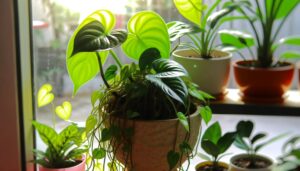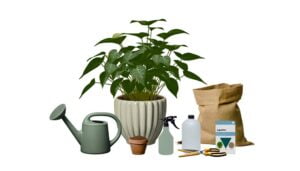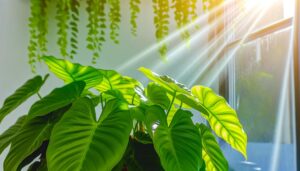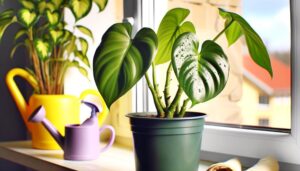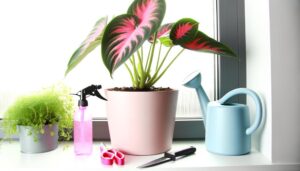How Do I Care for a Dark Green Heartleaf Philodendron?
To care for a dark green heartleaf philodendron, provide bright, indirect light around 200-400 foot-candles. Use a well-draining, peat-based soil and water when the top inch is dry, approximately every 7-10 days, with tepid, filtered water.
Maintain temperatures between 65°F and 80°F with 60-80% relative humidity. A balanced fertilizer with an N-P-K ratio of 20-20-20 should be applied bi-monthly during the growing season.
Regular pruning of foliage encourages dense growth and vigor. Monitor for pests, using neem oil or insecticidal soap as required.
Adhere to these guidelines for a thriving philodendron and explore more for advanced care.

Key Takeaways
- Place in bright, indirect light near an east or north-facing window.
- Water when the top inch of soil is dry, approximately every 7-10 days.
- Maintain temperature between 65°F and 80°F, and humidity levels at 60-80%.
- Fertilize bi-monthly with a balanced 20-20-20 N-P-K ratio during the growing season.
- Regularly inspect for pests and use natural remedies like neem oil or insecticidal soap.
Light Requirements
The dark green heartleaf philodendron (Philodendron hederaceum) thrives in bright, indirect light, which optimizes its photosynthetic efficiency and promotes robust growth. Position the plant near an east or north-facing window, ensuring it receives approximately 200-400 foot-candles of light.
Avoid direct sunlight, as it may cause photoinhibition, leading to chlorophyll degradation and leaf burn. In suboptimal lighting conditions, the plant may exhibit etiolation, characterized by elongated stems and sparse foliage, compromising its aesthetic and physiological health.
For artificial lighting, use full-spectrum fluorescent bulbs, maintaining a distance of 12-18 inches from the plant. Regularly monitor light intensity using a light meter, adjusting as necessary to maintain ideal conditions, thereby ensuring the philodendron’s continued importance and ornamental appeal.
Watering Schedule
Maintaining an ideal watering schedule for the dark green heartleaf philodendron is essential, requiring a balance between guaranteeing sufficient hydration and preventing waterlogged conditions. This tropical plant thrives when its potting medium remains consistently moist but not saturated.
Water the philodendron when the top inch of soil feels dry to the touch, typically every 7-10 days depending on ambient humidity and temperature. Employ tepid, filtered water to avoid shocking the roots. Over-watering can lead to root rot, characterized by yellowing leaves and a mushy stem. Conversely, under-watering manifests as wilting and browning leaf tips.
Implementing consistent monitoring and adjusting the watering frequency according to seasonal variations ensures the physiological health and strength of your heartleaf philodendron.
Soil and Potting
Selecting a suitable soil mix for the dark green heartleaf philodendron is essential, ideally a well-draining, peat-based potting medium enriched with perlite or orchid bark to guarantee best root aeration and moisture retention. This blend replicates the plant’s native tropical environment, maximizing nutrient uptake and preventing root rot.
Repotting should be conducted biennially during the spring growth phase to accommodate root expansion and replenish soil health. Select a container with drainage holes to mitigate waterlogging, which can lead to anaerobic conditions detrimental to root health.
During repotting, gently loosen the root ball and remove any decayed roots. This ensures the philodendron’s root system remains strong, facilitating optimal physiological functions and overall plant health.
Temperature and Humidity
Maintaining the right temperature and humidity levels is essential for the best growth of the Dark Green Heartleaf Philodendron. This plant thrives in an environment where the temperature is consistently between 65°F and 80°F, mirroring its native tropical habitat.
Moreover, ensuring a relative humidity level of 60-80% will support vigorous leaf development and overall plant health.
Ideal Temperature Range
The best temperature range for a dark green Heartleaf Philodendron (Philodendron hederaceum) is between 65°F and 80°F, with a relative humidity level of 60% to 80%. Maintaining this temperature range is essential for ideal physiological processes, including photosynthesis and transpiration.
When temperatures fall below 55°F, cellular metabolism can slow, leading to stunted growth and potential leaf chlorosis. Conversely, temperatures exceeding 85°F may cause excessive transpiration, leading to dehydration and wilting.
To guarantee the plant thrives, avoid placing it near drafts or heat sources. A consistent ambient temperature that mimics its native tropical environment will support vigorous growth and resilience. Regular monitoring with a digital thermometer and hygrometer is recommended for precision.
Maintaining Optimal Humidity
Achieving the suitable humidity levels is equally essential for the best growth of a dark green Heartleaf Philodendron, ensuring that physiological functions such as stomatal conductance and gas exchange are efficiently maintained.
Maintain ambient humidity between 60-70% to optimize foliar health and promote robust growth. Utilize a hygrometer to monitor indoor humidity levels accurately.
If humidity falls below ideal levels, employ a humidifier or place a water tray near the plant to enhance moisture in the surrounding air. Misting the foliage can also provide temporary relief, although it is less effective long-term.
Proper humidity supports turgor pressure in cells, facilitating nutrient uptake and minimizing transpiration stress, thereby ensuring overall strength and resilience of your Philodendron.
Fertilizing Tips
Regular fertilization is essential for the best growth and vibrant coloration of a dark green heartleaf philodendron, ensuring the plant receives a balanced supply of macro and micronutrients. Employ a water-soluble, balanced fertilizer with an N-P-K ratio of 20-20-20.
Administer the fertilizer bi-monthly during the active growing season, typically from spring through early autumn. Dilute the fertilizer to half the recommended strength to prevent root burn and nutrient toxicity.
Observe for signs of nutrient deficiencies such as chlorosis or stunted growth, adjusting the fertilization schedule if necessary. During winter dormancy, reduce fertilization frequency to avoid overstimulation.
Ensuring consistent nutrient availability supports robust photosynthesis, cellular respiration, and overall plant vigor, enhancing the philodendron’s aesthetic appeal and health.
Pruning Techniques
Pruning a dark green heartleaf philodendron involves the strategic removal of damaged, yellowing, or excessively long stems to promote healthier growth and maintain a compact, aesthetically pleasing form.
Begin by sterilizing pruning shears to prevent pathogen transmission. Identify stems exhibiting chlorosis or necrosis, and excise these sections just above a leaf node to encourage new growth.
For overly elongated stems, trim back to a desired length, ensuring cuts are clean and angled to minimize water accumulation and potential rot. Regular pruning can stimulate denser foliage and mitigate etiolation, enhancing the plant’s vigor and ornamental appeal.
Consistent monitoring and timely intervention are essential in maintaining the physiological balance and overall health of the philodendron.
Dealing With Pests
In managing the health of a Dark Green Heartleaf Philodendron, it is important to recognize and address pest infestations promptly.
Identifying common pests, such as aphids, spider mites, and mealybugs, is necessary for maintaining plant vitality.
Employing natural pest remedies and implementing effective prevention strategies will help the philodendron remain strong and vibrant.
Identifying Common Pests
To maintain the health of a dark green Heartleaf Philodendron, it is crucial to identify and manage common pests such as aphids, spider mites, and mealybugs. Aphids, small sap-sucking insects, can cause leaf curling and stunted growth.
Spider mites, which are microscopic arachnids, create fine webbing and lead to chlorotic (yellowish) spots on leaves. Mealybugs, identifiable by their cotton-like appearance, excrete honeydew that fosters sooty mold growth.
| Pest | Symptoms | Visual Indicators |
|---|---|---|
| Aphids | Leaf curling, stunted growth | Small, green or black insects |
| Spider Mites | Chlorotic spots, fine webbing | Tiny, moving specks, webbing |
| Mealybugs | Honeydew, sooty mold | White, cotton-like clusters |
Accurate identification enables prompt and effective intervention, ensuring the plant’s health.
Natural Pest Remedies
Implementing natural pest remedies can effectively manage aphids, spider mites, and mealybugs on a dark green Heartleaf Philodendron without resorting to chemical treatments. Utilizing these methods protects both the plant’s physiology and the surrounding environment.
Here are some scientifically-backed solutions:
- Neem Oil: Apply a diluted neem oil solution directly to the leaves. Neem oil disrupts the feeding and reproductive cycles of pests.
- Insecticidal Soap: Use a homemade insecticidal soap, consisting of mild liquid soap and water, to suffocate soft-bodied insects.
- Rubbing Alcohol: Dab a cotton swab in 70% isopropyl alcohol and treat infested areas, which dehydrates the pests.
- Beneficial Insects: Introduce ladybugs or predatory mites to the plant, which naturally prey on harmful pests.
Employing these methods safeguards the health of your Heartleaf Philodendron.
Prevention Tips
Regularly inspecting your dark green Heartleaf Philodendron for early signs of infestation is crucial in preventing pest problems. Examine the undersides of leaves and stems where pests such as aphids, spider mites, and mealybugs typically congregate. Utilize a magnifying glass for detailed inspection.
Maintain optimal environmental conditions, such as keeping a humidity level of 40-60%, as this discourages pest proliferation. Cleaning the leaves with a damp cloth removes dust and potential pests. Quarantine new plants for at least two weeks to prevent cross-contamination.
If an infestation is detected, isolate the affected plant and treat it with insecticidal soap or neem oil. Consistent monitoring and prompt intervention protect the plant’s physiological health and aesthetic value, ensuring its longevity.
Do Heartleaf Philodendron Flower
Yes, heartleaf philodendron (Philodendron hederaceum) can flower, but it rarely does so indoors. When grown in its natural tropical habitat, it produces small, greenish-white flowers that are typically not very showy. The plant is primarily cultivated for its attractive heart-shaped leaves rather than its flowers.
Conclusion
To sum up, the care of a dark green heartleaf philodendron requires meticulous attention to light, water, soil, temperature, humidity, and fertilization.
As the saying goes, ‘Prevention is better than cure.’ Correct pruning methods and pest control are crucial in preserving plant vigor.
Following these recommendations will guarantee the plant’s peak growth and health. Proficiency in these techniques will lead to a thriving philodendron, showcasing a harmonious indoor ecosystem.

